Effect of Climate Variability Events over the Colombian Caribbean Offshore Wind Resource
Abstract
:1. Introduction
2. Materials and Methods
2.1. Data Management
2.1.1. Study Area and Database
2.1.2. Climatic Indices
3. Results
3.1. Wind Resource Characterization
3.1.1. Wind Climatology
3.1.2. Linear Correlation and Trends
3.1.3. CDF Analysis
4. Discussion
4.1. Climate Scenarios
4.1.1. Long-Term Scenario: AMO
4.1.2. Middle-Term Scenario: AMO + ENSO
4.1.3. Short-Term Scenario: AMO + ENSO + Season
5. Conclusions
- Long-term scenario (AMO), showed that from the identified 28 LWS values along the time series (1980–2019), 20 (71%) were found during AMO positive and 8 (29%) in AMO negative. The lowest LWS (2.403 m/s) occurred during positive AMO. The wind speed increases in the negative phase of the AMO and decrease in its positive phase. The largest fluctuations in the wind magnitude were found during the positive phase, but the lowest values were recorded during the negative phase.
- Middle-term scenario (AMO + ENSO): the second lowest LWS (3.140 m/s) retrieved from the time series occurred during a positive AMO combined with La Niña event (nov-99). A significant positive correlation was found between wind speed and La Niña events during the AMO positive phase.
- Short-term scenario (AMO + ENSO + season): the positive anomalies of SST in the Caribbean, and low SST in the tropical Pacific due to La Niña (2011) reduced the wind speed of the CLLJ.
- The climatology of the Caribbean winds showed a semi-annual variation, with two maxima in the summer (JJA) and winter (DJF) and two minima in the autumn (SON) and spring (May).
Author Contributions
Funding
Data Availability Statement
Acknowledgments
Conflicts of Interest
References
- Cabello, J.J.; Balbis, M.; Sagastume, A.; Pardo, A.; Cabello, M.J.; Rey, F.J.; Rueda-Bayona, J.G. A look to the electricity generation from non-conventional renewable energy sources in Colombia. Int. J. Energy Econ. Policy 2019, 9, 15–25. [Google Scholar] [CrossRef]
- Sagastume Gutiérrez, A.; Balbis Morejón, M.; Cabello Eras, J.J.; Cabello Ulloa, M.; Rey Martínez, F.J.; Rueda-Bayona, J.G. Data supporting the forecast of electricity generation capacity from non-conventional renewable energy sources in Colombia. Data Br. 2020, 28, 104949. [Google Scholar] [CrossRef]
- Valentine, S.V. Emerging symbiosis: Renewable energy and energy security. Renew. Sustain. Energy Rev. 2011, 15, 4572–4578. [Google Scholar] [CrossRef]
- González, J.; Etter, A.; Sarmiento, A.; Orrego, S.; Ramírez, C.; Cabrera, E.; Vargas, D.; Galindo, G.; García, M.; Ordoñez, M. Análisis de Tendencias y Patrones Espaciales de Deforestación En Colombia; Instituto de Hidrología, Meteorología y Estudios Ambientales-IDEAM: Santander, Spain, 2017; ISBN 9789588067483. [Google Scholar]
- World Energy Council. World Energy Trilemma Index 2020; World Energy Council: London, UK, 2020. [Google Scholar]
- Kruyt, B.; van Vuuren, D.P.; de Vries, H.J.M.; Groenenberg, H. Indicators for energy security. Energy Policy 2009, 37, 2166–2181. [Google Scholar] [CrossRef]
- APERC. A Quest for Energy Security in the 21st Century; Asia Pacific Energy Research Centre: Tokyo, Japan, 2007. [Google Scholar]
- Cherp, A.; Jewell, J. The concept of energy security: Beyond the four as. Energy Policy 2014, 75, 415–421. [Google Scholar] [CrossRef] [Green Version]
- Edenhofer, O.; Pichis-Madruga, P.M.; Sokona, Y. Fuentes de Energía Renovables y Mitigación Del Cambio Climatico; Prensa de la Universidad de Cambridge: Cambridge, UK, 2011; ISBN 9789291693313. [Google Scholar]
- Esteban, M.D.; Diez, J.J.; López, J.S.; Negro, V. Why offshore wind energy? Renew. Energy 2011, 36, 444–450. [Google Scholar] [CrossRef] [Green Version]
- Pimenta, F.; Kempton, W.; Garvine, R. Combining meteorological stations and satellite data to evaluate the offshore wind power resource of Southeastern Brazil. Renew. Energy 2008, 33, 2375–2387. [Google Scholar] [CrossRef]
- Costoya, X.; deCastro, M.; Santos, F.; Sousa, M.C.; Gómez-Gesteira, M. Projections of wind energy resources in the Caribbean for the 21st century. Energy 2019, 178, 356–367. [Google Scholar] [CrossRef]
- Wang, C. Variability of the Caribbean Low-Level Jet and its relations to climate. Clim. Dyn. 2007, 29, 411–422. [Google Scholar] [CrossRef] [Green Version]
- Wang, C.; Lee, S.K. Atlantic warm pool, Caribbean low-level jet, and their potential impact on Atlantic hurricanes. Geophys. Res. Lett. 2007, 34, 1–5. [Google Scholar] [CrossRef] [Green Version]
- Muñoz, E.; Busalacchi, A.J.; Nigam, S.; Ruiz-Barradas, A. Winter and summer structure of the Caribbean low-level jet. J. Clim. 2008, 21, 1260–1276. [Google Scholar] [CrossRef]
- Zheng, C.W.; Li, C.Y.; Li, X. Recent Decadal Trend in the North Atlantic Wind Energy Resources. Adv. Meteorol. 2017, 2017, 7257492. [Google Scholar] [CrossRef] [Green Version]
- Chadee, X.T.; Clarke, R.M. Large-scale wind energy potential of the Caribbean region using near-surface reanalysis data. Renew. Sustain. Energy Rev. 2014, 30, 45–58. [Google Scholar] [CrossRef]
- Rueda-Bayona, J.G.; Guzmán, A.; Eras, J.J.C.; Silva-Casarín, R.; Bastidas-Arteaga, E.; Horrillo-Caraballo, J. Renewables energies in Colombia and the opportunity for the offshore wind technology. J. Clean. Prod. 2019, 263, 121584. [Google Scholar] [CrossRef]
- Rueda-Bayona, J.G.; Guzmán, A.; Eras, J.J.C. Wind and power density data of strategic offshore locations in the Colombian Caribbean coast. Data Br. 2019, 27, 1–4. [Google Scholar] [CrossRef]
- Jung, C.; Taubert, D.; Schindler, D. The temporal variability of global wind energy—Long-term trends and inter-annual variability. Energy Convers. Manag. 2019, 188, 462–472. [Google Scholar] [CrossRef]
- Pryor, S.C.; Barthelmie, R.J.; Schoof, J.T. Inter-annual variability of wind indices across Europe. Wind Energy An. Int. J. Prog. Appl. Wind Power Convers. Technol. 2006, 9, 27–38. [Google Scholar] [CrossRef]
- Valentine, S.V. Understanding the variability of wind power costs. Renew. Sustain. Energy Rev. 2011, 15, 3632–3639. [Google Scholar] [CrossRef]
- Whyte, F.S.; Taylor, M.A.; Stephenson, T.S.; Campbell, J.D. Features of the Caribbean low level jet. Int. J. Climatol. 2008, 28, 119–128. [Google Scholar] [CrossRef]
- Poveda, G.; Álvarez, D.M.; Rueda, Ó.A. Hydro-climatic variability over the Andes of Colombia associated with ENSO: A review of climatic processes and their impact on one of the Earth’s most important biodiversity hotspots. Clim. Dyn. 2011, 36, 2233–2249. [Google Scholar] [CrossRef]
- Poveda, G.; Waylen, P.R.; Pulwarty, R.S. Annual and inter-annual variability of the present climate in northern South America and southern Mesoamerica. Palaeogeogr. Palaeoclimatol. Palaeoecol. 2006, 234, 3–27. [Google Scholar] [CrossRef]
- Henao, F.; Viteri, J.P.; Rodríguez, Y.; Gómez, J.; Dyner, I. Annual and interannual complementarities of renewable energy sources in Colombia. Renew. Sustain. Energy Rev. 2020, 134, 110318. [Google Scholar] [CrossRef]
- Klotzbach, P.J. The influence of El Niño-Southern Oscillation and the Atlantic multidecadal Oscillation on Caribbean tropical cyclone activity. J. Clim. 2011, 24, 721–731. [Google Scholar] [CrossRef]
- Stephenson, T.S.; Vincent, L.A.; Allen, T.; Van Meerbeeck, C.J.; Mclean, N.; Peterson, T.C.; Taylor, M.A.; Aaron-Morrison, A.P.; Auguste, T.; Bernard, D.; et al. Changes in extreme temperature and precipitation in the Caribbean region, 1961–2010. Int. J. Climatol. 2014, 34, 2957–2971. [Google Scholar] [CrossRef]
- Andrade, C. Análisis de la velocidad del viento en el mar Caribe. Boletín Científico CIOH 1993, 13, 33–43. [Google Scholar] [CrossRef]
- Schneider, T.; Bischoff, T.; Haug, G.H. Migrations and dynamics of the intertropical convergence zone. Nature 2014, 513, 45–53. [Google Scholar] [CrossRef] [PubMed]
- Karimirad, M. Offshore Energy Structures; Springer: Berlin, Germany, 2014. [Google Scholar]
- Bastidas-Salamanca, M.; Rueda-Bayona, J. Pre-feasibility assessment for identifying locations of new offshore wind projects in the Colombian Caribbean. Int. J. Sustain. Energy Plan. Manag. 2021, 32, 139–154. [Google Scholar] [CrossRef]
- Amador, J.A. The Intra-Americas Sea low-level jet: Overview and future research. Ann. N. Y. Acad. Sci. 2008, 1146, 153–188. [Google Scholar] [CrossRef] [Green Version]
- Appendini, C.M.; Urbano-Latorre, C.P.; Figueroa, B.; Dagua-Paz, C.J.; Torres-Freyermuth, A.; Salles, P. Wave energy potential assessment in the Caribbean Low Level Jet using wave hindcast information. Appl. Energy 2015, 137, 375–384. [Google Scholar] [CrossRef]
- Cook, K.H.; Vizy, E.K. Hydrodynamics of the Caribbean low-level jet and its relationship to precipitation. J. Clim. 2010, 23, 1477–1494. [Google Scholar] [CrossRef]
- Chang, Y.L.; Oey, L.Y. Coupled response of the trade wind, SST gradient, and SST in the caribbean sea, and the potential impact on loop current’s interannual variability. J. Phys. Oceanogr. 2013, 43, 1325–1344. [Google Scholar] [CrossRef]
- Ibrahim, H.; Ghandour, M.; Dimitrova, M.; Ilinca, A.; Perron, J. Integration of wind energy into electricity systems: Technical challenges and actual solutions. Energy Procedia 2011, 6, 815–824. [Google Scholar] [CrossRef] [Green Version]
- Ruiz-Ochoa, M.; Bernal, G. Seasonal and interannual wind variability into the NCEP / NCAR reanalysis data on the Colombian basin, Caribbean sea. Av. En Recur. Hidráulicos 2009, 20, 7–20. [Google Scholar]
- Bastidas Salamanca, M.L.; Figueroa Casas, A. Seguimiento satelital de las condiciones océano-atmosféricas asociadas a los eventos de precipitación en Colombia durante el evento La Niña 2010–2011. Boletín Científico CIOH 2014, 32, 123–134. [Google Scholar] [CrossRef]
- Hoyos, N.; Escobar, J.; Restrepo, J.C.; Arango, A.M.; Ortiz, J.C. Impact of the 2010–2011 La Niña phenomenon in Colombia, South America: The human toll of an extreme weather event. Appl. Geogr. 2013, 39, 16–25. [Google Scholar] [CrossRef]
- Giannini, A.; Cane, M.A.; Kushnir, Y. Interdecadal Changes in the ENSO Teleconnection to the Caribbean Region and the North Atlantic Oscillation. J. Clim. 2001, 14, 2867–2879. [Google Scholar] [CrossRef]
- Taylor, M.A.; Enfield, D.B.; Chen, A.A. Influence of the tropical Atlantic versus the tropical Pacific on Caribbean rainfall. J. Geophys. Res. Ocean. 2002, 107, 10–11. [Google Scholar] [CrossRef] [Green Version]
- Edsand, H.E. Identifying barriers to wind energy diffusion in Colombia: A function analysis of the technological innovation system and the wider context. Technol. Soc. 2017, 49, 1–15. [Google Scholar] [CrossRef]
- Makridis, C. Offshore wind power resource availability and prospects: A global approach. Environ. Sci. Policy 2013, 33, 28–40. [Google Scholar] [CrossRef]
- Schwanitz, V.J.; Wierling, A. Offshore wind investments—Realism about cost developments is necessary. Energy 2016, 106, 170–181. [Google Scholar] [CrossRef]
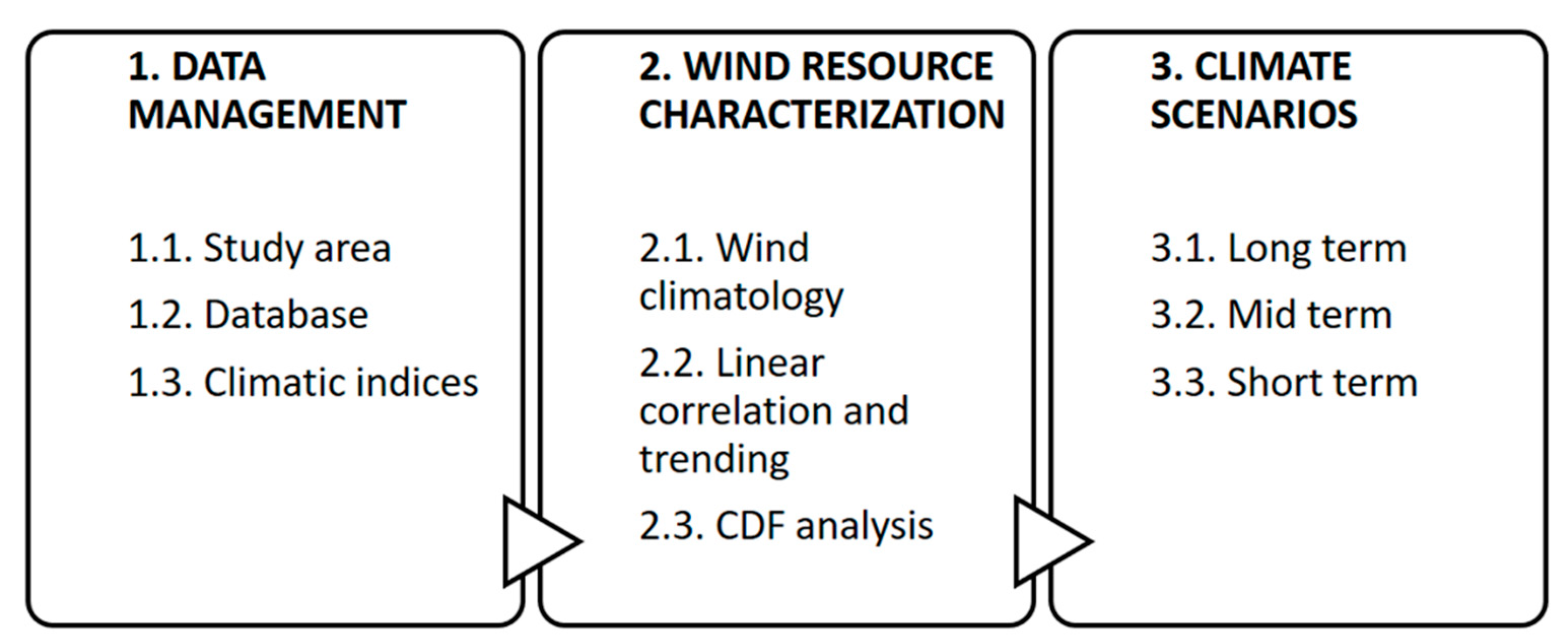
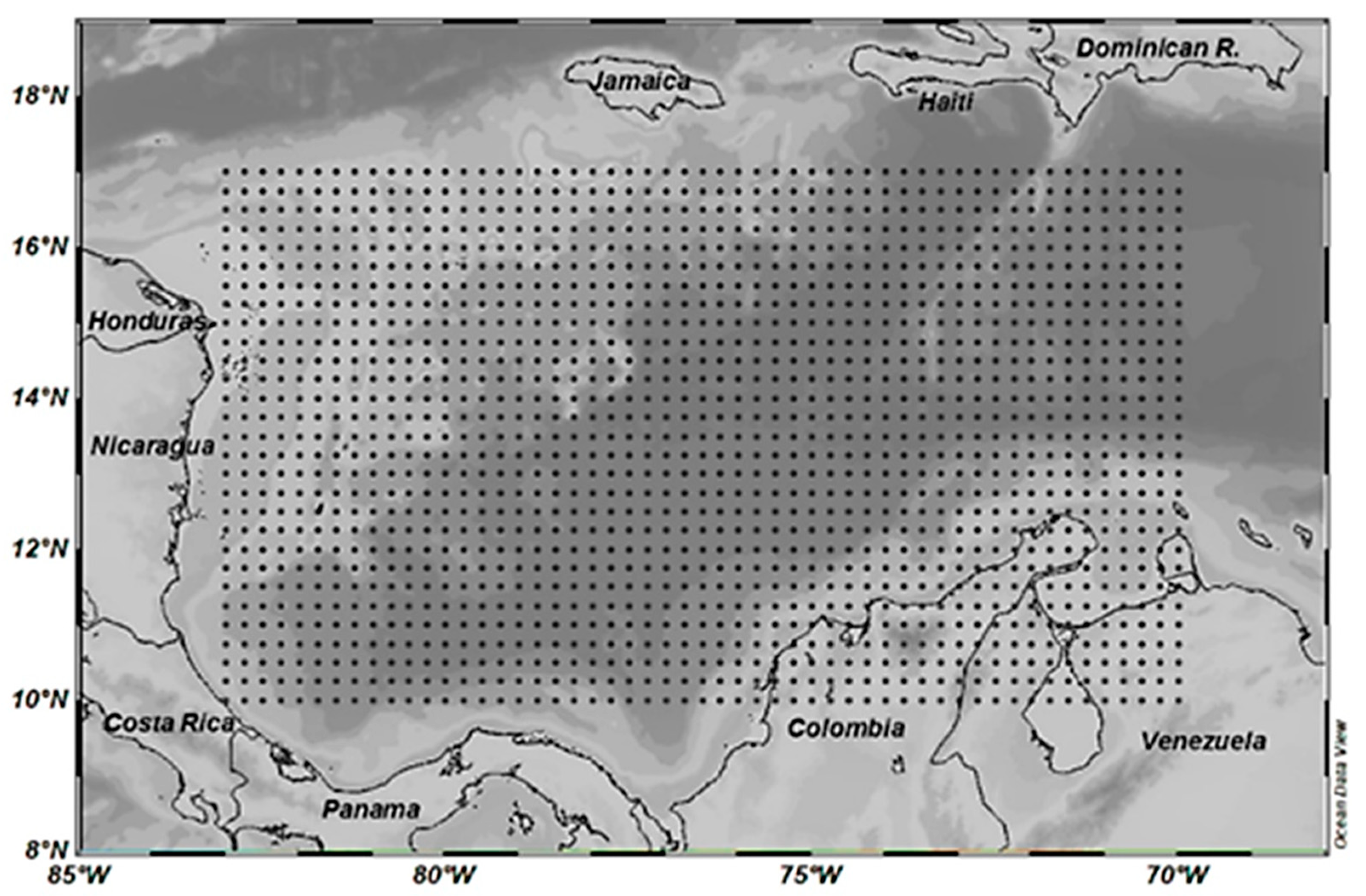

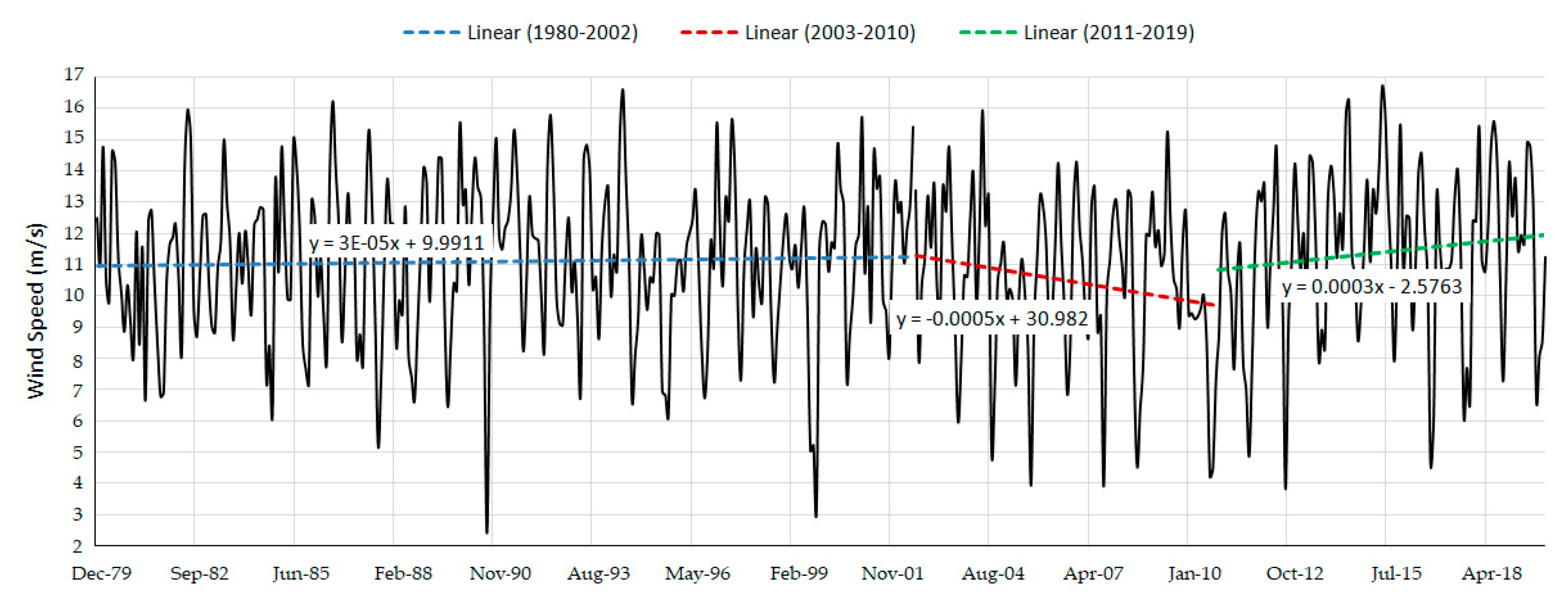
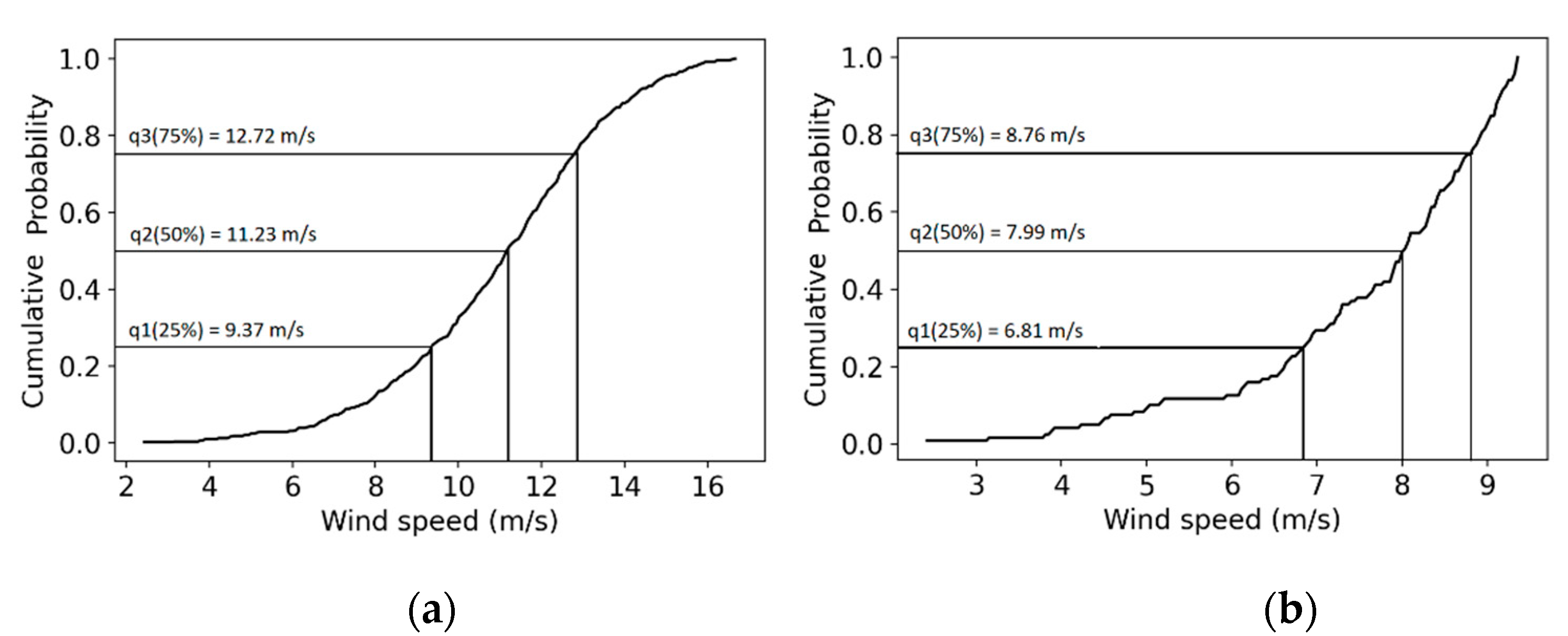
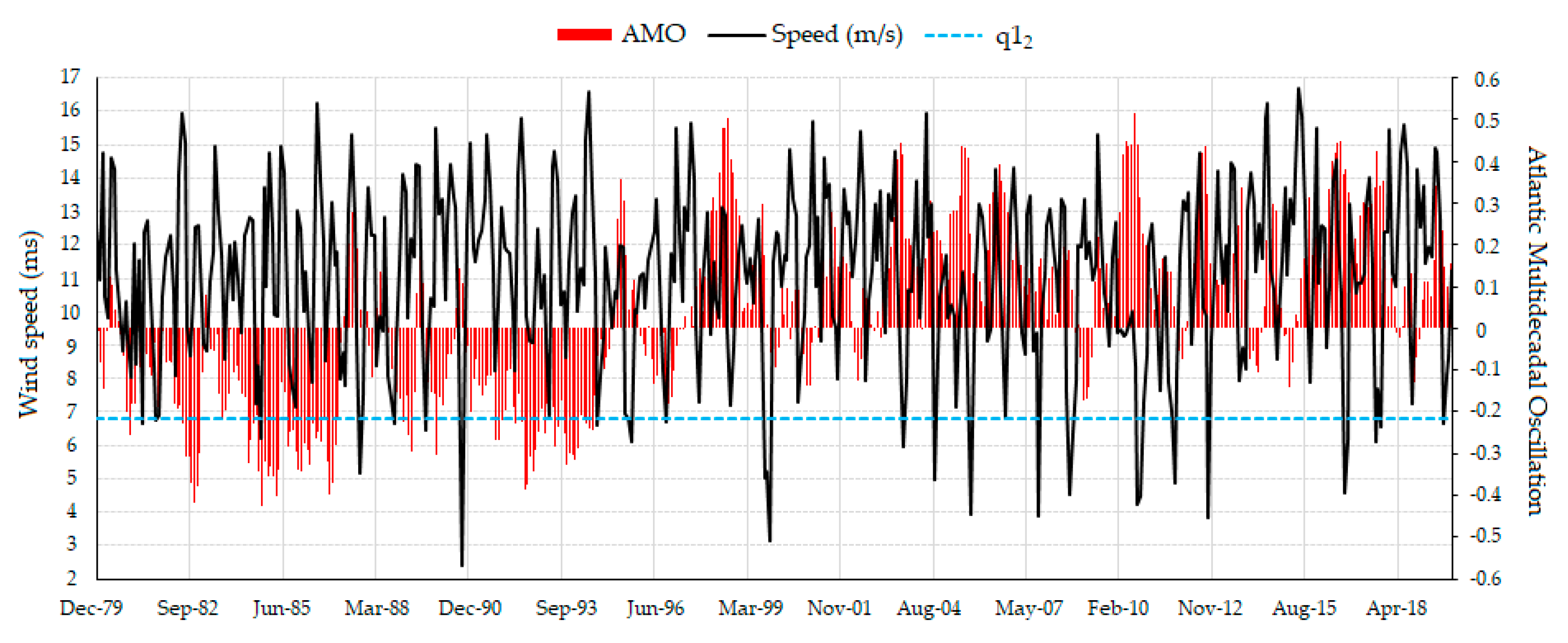
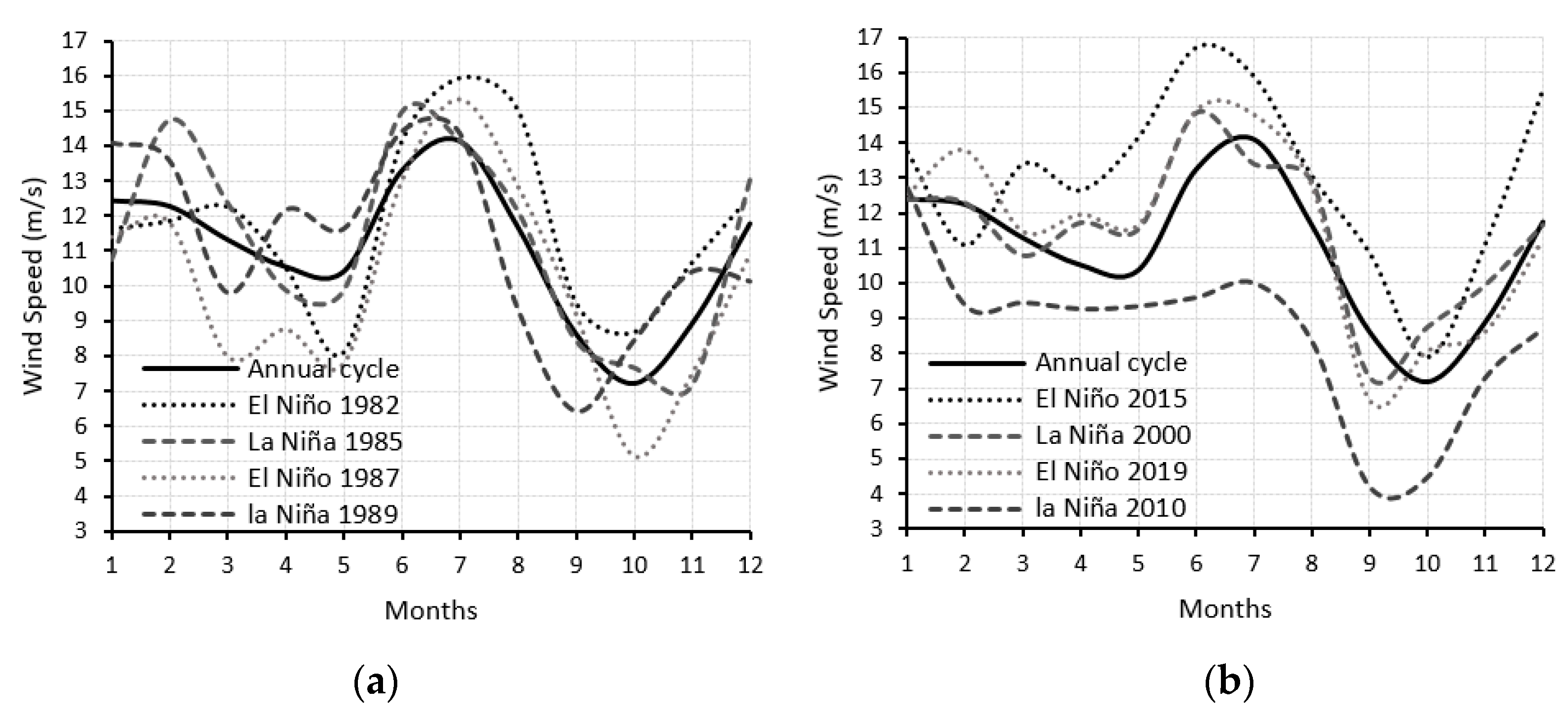
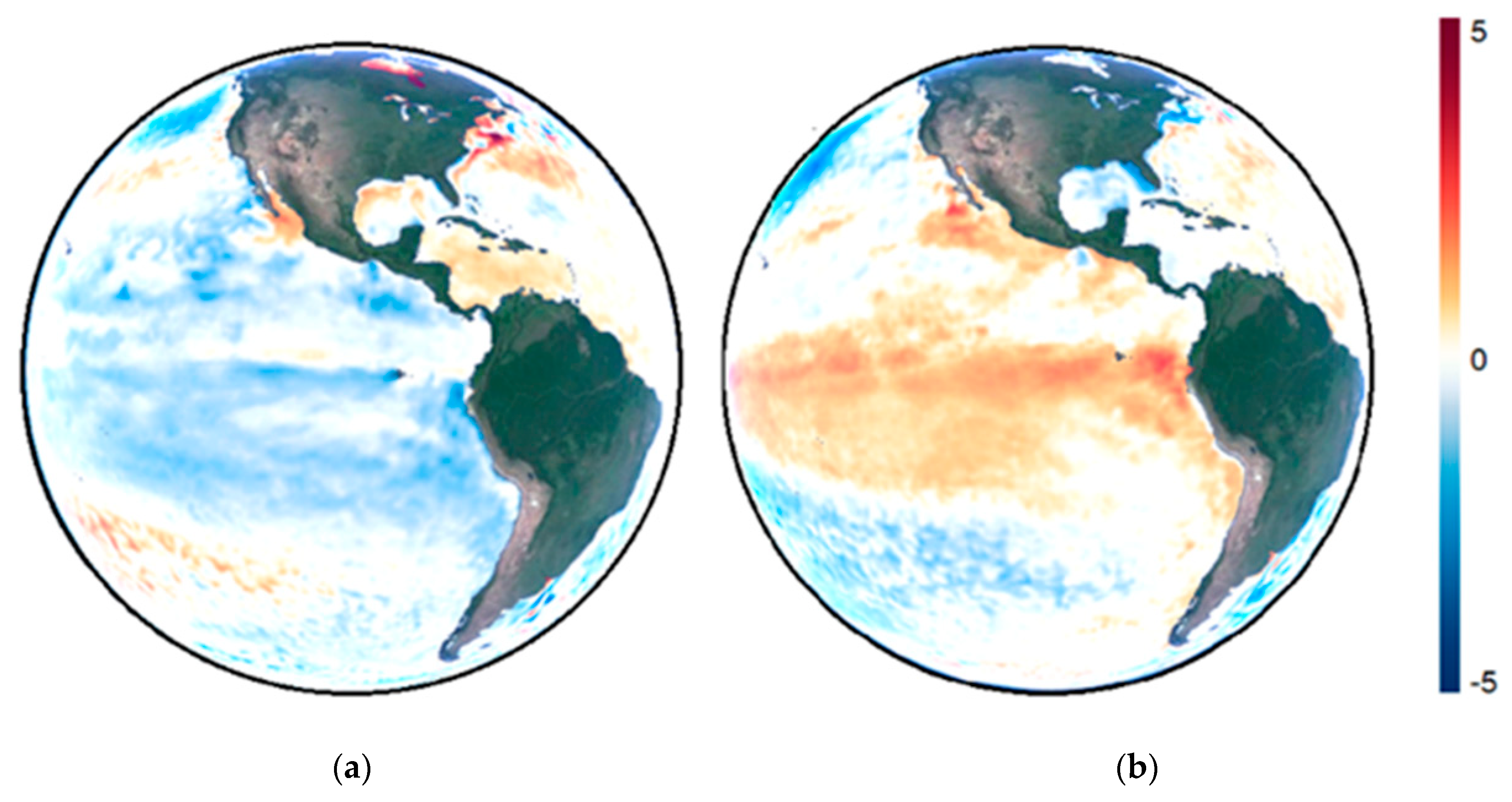
| Date (Month-Year) | Wind Speed (m/s) | ONI (ENSO) | AMO |
|---|---|---|---|
| May-81 | 6.640 | −0.300 | −0.084 |
| Oct-81 | 6.760 | −0.100 | −0.187 |
| Nov-84 | 6.185 | −0.900 | −0.424 |
| Oct−87 | 5.161 | 1.500 | 0.046 |
| Oct-88 | 6.637 | −1.500 | −0.175 |
| Sep−89 | 6.446 | −0.200 | −0.099 |
| Oct-90 | 2.403 | 0.300 | 0.108 |
| Oct-94 | 6.611 | 0.700 | −0.067 |
| Oct-95 | 6.123 | −1.000 | 0.094 |
| Oct-96 | 6.717 | −0.400 | −0.153 |
| Sep-99 | 5.034 | −1.200 | 0.176 |
| Oct-99 | 5.221 | −1.300 | 0.008 |
| Nov-99 | 3.140 | −1.50 | −0.058 |
| Oct-03 | 5.950 | 0.300 | 0.417 |
| Sep-04 | 4.987 | 0.700 | 0.231 |
| Oct-05 | 3.921 | −0.300 | 0.228 |
| Oct-07 | 3.892 | −1.400 | 0.148 |
| Sep-08 | 4.520 | −0.300 | 0.189 |
| Oct-08 | 6.346 | −0.400 | 0.093 |
| Sep-10 | 4.217 | −1.600 | 0.440 |
| Oct-10 | 4.482 | −1.700 | 0.314 |
| Oct-11 | 4.864 | −1.100 | 0.053 |
| Oct-12 | 3.817 | 0.200 | 0.32 |
| Oct-16 | 4.577 | −0.700 | 0.37 |
| Nov-16 | 6.144 | −0.700 | 0.38 |
| Sep-17 | 6.112 | −0.400 | 0.339 |
| Nov-17 | 6.563 | −0.900 | 0.341 |
| Sep-19 | 6.657 | 0.100 | 0.235 |
Publisher’s Note: MDPI stays neutral with regard to jurisdictional claims in published maps and institutional affiliations. |
© 2021 by the authors. Licensee MDPI, Basel, Switzerland. This article is an open access article distributed under the terms and conditions of the Creative Commons Attribution (CC BY) license (https://creativecommons.org/licenses/by/4.0/).
Share and Cite
Bastidas-Salamanca, M.; Rueda-Bayona, J.G. Effect of Climate Variability Events over the Colombian Caribbean Offshore Wind Resource. Water 2021, 13, 3150. https://doi.org/10.3390/w13223150
Bastidas-Salamanca M, Rueda-Bayona JG. Effect of Climate Variability Events over the Colombian Caribbean Offshore Wind Resource. Water. 2021; 13(22):3150. https://doi.org/10.3390/w13223150
Chicago/Turabian StyleBastidas-Salamanca, Martha, and Juan Gabriel Rueda-Bayona. 2021. "Effect of Climate Variability Events over the Colombian Caribbean Offshore Wind Resource" Water 13, no. 22: 3150. https://doi.org/10.3390/w13223150
APA StyleBastidas-Salamanca, M., & Rueda-Bayona, J. G. (2021). Effect of Climate Variability Events over the Colombian Caribbean Offshore Wind Resource. Water, 13(22), 3150. https://doi.org/10.3390/w13223150







